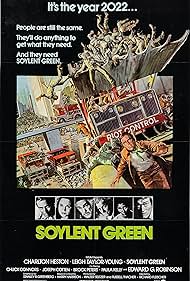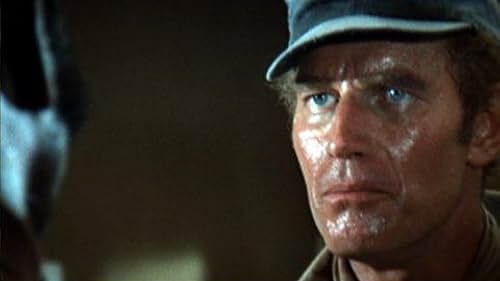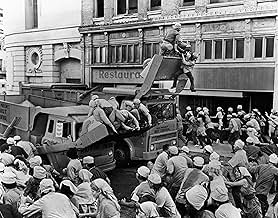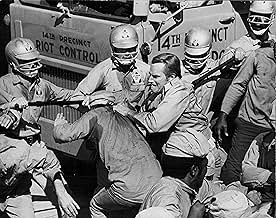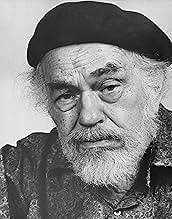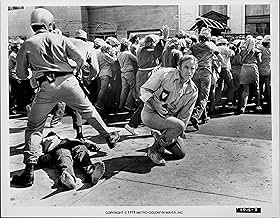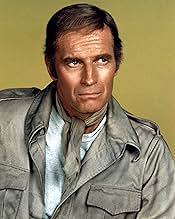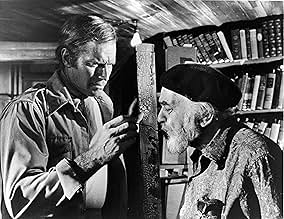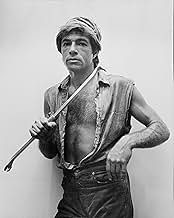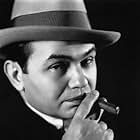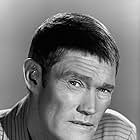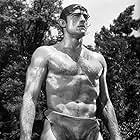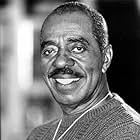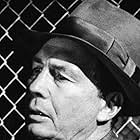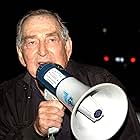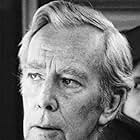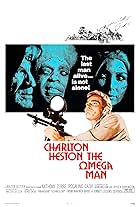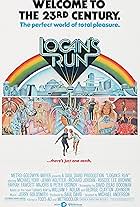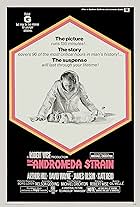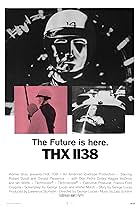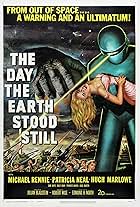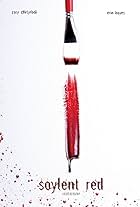A nightmarish futuristic fantasy about the controlling power of big corporations and an innocent cop who stumbles on the truth.A nightmarish futuristic fantasy about the controlling power of big corporations and an innocent cop who stumbles on the truth.A nightmarish futuristic fantasy about the controlling power of big corporations and an innocent cop who stumbles on the truth.
- Awards
- 3 wins & 1 nomination
- Director
- Writers
- All cast & crew
- Production, box office & more at IMDbPro
Storyline
Did you know
- Trivia(at around 33 mins) The scene where Thorn and Roth share a meal of fresh food was not originally in the script, but was ad-libbed by Charlton Heston and Edward G. Robinson at director Richard Fleischer's request.
- Goofs(at around 9 mins) The piece of meat Shirl buys for Simonson is clearly not the same piece Thorn unwraps in front of Sol (at around 23 mins).
- Quotes
Sol: [Thorn is seeing the beautiful images shown in Sol's euthanasia chamber] Can you see it?
Det. Thorn: [choked up] Yes...
Sol: Isn't it beautiful?
Det. Thorn: Oh, yes...
Sol: I told you.
Det. Thorn: [humbly] How could I know? How could I... how could I ever imagine?
- Alternate versionsDeleted scene: When Tab Fielding (Chuck Connors) goes shopping with Shirl, he is mugged, and wins the fight. This scene was filmed, but deleted.
- ConnectionsEdited from Far from the Madding Crowd (1967)
- SoundtracksSymphony No. 6 in B Minor, Op.74: 'Pathetique': I. Adagio - Allegro non Troppo
(uncredited)
By Pyotr Ilyich Tchaikovsky
Featured review
"Soylent green" is an ecological dystopia that may not be a highlight in film history but that surely gives something to think about.
I saw it on television in 2022, the year in which the film is situated. The year also in which global warming / climate change was a real ecological worry. The film was made in 1973, a year after the Club of Rome had published his report "The limits to growth", questioning the sustainability of ongoing economic and population growth.
In the famous opening scene the effect of population growth and industrialization on the landscape is made visible, ultimately resulting in the city of New York containing 40 million inhabitants. Inhabitants feeding themselves with dried food of the company Soylent, because fresh fruit and vegetables is only affordable for the very rich.
Just like in a dystopia such as "Blade runner" (1982, Ridley Scott) the distinction between upper class and lower class is very big. Also this is a point of recognition in the "real" 2022, where growing inequality after years of neo liberalism, alongside environmental problems, is a concern. Unlike "Blade runner" the world (especially the interiors of the homes of the rich) is very 70's. As though the film accentuates that it is not the science that has evolved (for the better), but only the environment and the society (for the worse).
A minus for the film is in my opinion the role of women. They are portrayed as a sort of furniture in the houses of the rich. Furniture that is mainly there to be sexy. Overpopulation damaging the environment is plausible, overpopulation rolling back the emancipation of women is much less so.
One of the most provocative and best scenes is an old man choosing for euthanasia. He remembers very wel that he has lived in a better world long ago and he has seen enough. Even in 2022 the issue of euthanasia because you suffer from life itself (and not from some kind of disease) is very controversial. The euthanasia ceremoy consists of beautiful images of nature accompanied by the Pastoral symphony of Beethoven. With the exception of Disney's "Fantasia" (1940) this music has never been used so well in film. This dying scene was played by the old Edward G, Robinson, who died in the year "Soylent green" was released. This dying scene was the last scene in his long career.
The film ends with a shocking discovery. Of course I am not going to disclose this discovery, only that in the final scene the lead characters shouts his discovery to anyone who will listen. An ending very much alike that of "The invasion of the body snatchers" (1956, Don Siegel).
I saw it on television in 2022, the year in which the film is situated. The year also in which global warming / climate change was a real ecological worry. The film was made in 1973, a year after the Club of Rome had published his report "The limits to growth", questioning the sustainability of ongoing economic and population growth.
In the famous opening scene the effect of population growth and industrialization on the landscape is made visible, ultimately resulting in the city of New York containing 40 million inhabitants. Inhabitants feeding themselves with dried food of the company Soylent, because fresh fruit and vegetables is only affordable for the very rich.
Just like in a dystopia such as "Blade runner" (1982, Ridley Scott) the distinction between upper class and lower class is very big. Also this is a point of recognition in the "real" 2022, where growing inequality after years of neo liberalism, alongside environmental problems, is a concern. Unlike "Blade runner" the world (especially the interiors of the homes of the rich) is very 70's. As though the film accentuates that it is not the science that has evolved (for the better), but only the environment and the society (for the worse).
A minus for the film is in my opinion the role of women. They are portrayed as a sort of furniture in the houses of the rich. Furniture that is mainly there to be sexy. Overpopulation damaging the environment is plausible, overpopulation rolling back the emancipation of women is much less so.
One of the most provocative and best scenes is an old man choosing for euthanasia. He remembers very wel that he has lived in a better world long ago and he has seen enough. Even in 2022 the issue of euthanasia because you suffer from life itself (and not from some kind of disease) is very controversial. The euthanasia ceremoy consists of beautiful images of nature accompanied by the Pastoral symphony of Beethoven. With the exception of Disney's "Fantasia" (1940) this music has never been used so well in film. This dying scene was played by the old Edward G, Robinson, who died in the year "Soylent green" was released. This dying scene was the last scene in his long career.
The film ends with a shocking discovery. Of course I am not going to disclose this discovery, only that in the final scene the lead characters shouts his discovery to anyone who will listen. An ending very much alike that of "The invasion of the body snatchers" (1956, Don Siegel).
- frankde-jong
- Oct 10, 2022
- Permalink
Details
- Release date
- Country of origin
- Official sites
- Languages
- Also known as
- Make Room! Make Room!
- Filming locations
- Chevron Refinery Power Generating Station, 300 Vista del Mar, El Segundo, California, USA(Soylent factory Exterior)
- Production company
- See more company credits at IMDbPro
Box office
- Budget
- $4,000,000 (estimated)
- Gross worldwide
- $210
Contribute to this page
Suggest an edit or add missing content

